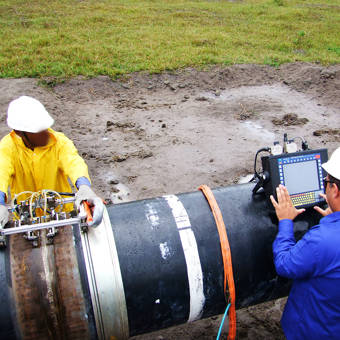Comprehensive Summary of Pipeline Welding Examination Treatments
Pipe welding assessment treatments play a vital duty in guaranteeing that bonded links meet stringent sector requirements and specs. From meticulous pre-welding inspections to comprehensive post-weld evaluations, a well-defined assessment process is important for preserving the structural strength of pipelines.
Pre-welding Evaluation Preparations
Prior to beginning the welding procedure, complete pre-welding inspection prep work are important to ensure the honesty and quality of the weld joint. These prep work include a precise exam of the materials to be bonded, the welding equipment, and the work environment. The products should be checked for any flaws, contaminants, or disparities that can compromise the weld. This consists of monitoring for appropriate product grades, measurements, and surface area problems. Pipeline Welding Inspection. Additionally, the welding devices requires to be evaluated to confirm that it remains in good working condition, adjusted correctly, and ideal for the specific welding procedure. Any problems with the devices should be attended to promptly to avoid flaws in the weld. Last but not least, the job atmosphere have to be reviewed for cleanliness, proper ventilation, and safety procedures to guarantee a helpful setup for the welding operation. By performing extensive pre-welding assessment prep work, prospective problems can be identified and resolved early, causing high-grade and reliable weld joints.
Welding Treatment Certification
Complete pre-welding examination preparations lay the structure for the crucial procedure of Welding Procedure Credentials, making sure the integrity and top quality of the weld joint. Welding Procedure Credentials (WPQ) is a vital action in the welding process that entails testing and licensing welding procedures to guarantee they meet certain standards and demands. The WPQ procedure generally includes welding treatment specification advancement, welding treatment certification screening, and documents of the results.
During welding treatment requirements development, necessary details such as the welding procedure, welding products, joint design, and welding criteria are defined to create a thorough procedure. Ultimately, welding procedure credentials screening is conducted to verify the recommended treatment's integrity. This testing commonly involves welding test discount coupons that undergo numerous mechanical and non-destructive examinations to assess the weld's high quality and adherence to the defined criteria.
In-process Weld Evaluation
During the welding process, in-process weld examination plays a vital duty in ensuring the quality and integrity of the weld joint - Pipeline Welding Inspection. This kind of examination involves monitoring the welding parameters, evaluating the weld bead formation, and discovering any type of potential problems or discontinuities as they occur. By performing in-process weld examinations, welding drivers can quickly resolve any issues that may arise, therefore preventing additional defects and making sure that the final weld meets the called for requirements
Usual techniques made use of for in-process weld evaluation consist of visual assessment, liquid penetrant screening, magnetic particle testing, ultrasonic testing, and radiographic screening. In general, in-process weld inspection is vital for maintaining the high quality and integrity of welded pipelines.
Non-destructive Screening (NDT)
Non-destructive Testing (NDT) is an essential technique used in pipeline welding evaluation to examine the honesty of weld joints without causing damage to the welded framework. By making use of numerous NDT techniques, inspectors can examine the top quality of welds and identify any problems or discontinuities that might endanger the architectural stability of the pipeline. Typical NDT techniques utilized in pipe welding inspection include Radiographic Testing (RT), Ultrasonic Testing (UT), Magnetic Bit Examining (MPT), Fluid Penetrant Testing (LPT), and Visual Testing (VT)
RT entails the usage of X-rays or gamma rays to create images of the inner structure of the weld, allowing assessors to identify issues such as porosity, fractures, or incomplete fusion. In addition, VT includes visual examination of welds to determine any noticeable blemishes.
Post-weld Assessment and Paperwork


Paperwork of post-weld inspection searchings for is essential for keeping quality assurance documents and guaranteeing conformity with market criteria and policies. Thorough reports need to include details about the assessment methods utilized, the area and nature of any great post to read flaws found, and any type of corrective activities taken - Pipeline Welding Inspection. Appropriate documents not only functions as a record of the weld's top quality however likewise help in future maintenance and assessment processes
Conclusion

Finally, pipeline welding evaluation treatments play an important duty in making sure the top quality and integrity of welds. From pre-welding assessments to post-weld documentation, each step is necessary in maintaining the security and performance of pipes. By complying with well-known procedures and performing extensive examinations, prospective issues can be identified and attended to prior to they lead to expensive repair services or failings. additional info Overall, adherence to correct inspection procedures is crucial to the success of pipeline welding projects.
From precise pre-welding examinations to extensive post-weld evaluations, a well-defined inspection procedure is important for preserving the structural stability of pipelines. By conducting in-process weld inspections, welding drivers can without delay resolve any kind of problems that may occur, thereby preventing more issues and making certain that the final weld fulfills the needed specs.
Typical methods used for in-process weld examination consist of visual inspection, fluid penetrant screening, magnetic bit screening, ultrasonic testing, and radiographic screening.Non-destructive Screening (NDT) is an important technique employed in pipeline welding examination to analyze the stability of weld joints without triggering damage to the bonded structure. Post-weld examination includes various approaches to evaluate the see here welds for issues, including aesthetic inspection, color penetrant testing, magnetic bit testing, ultrasonic screening, and radiographic screening.